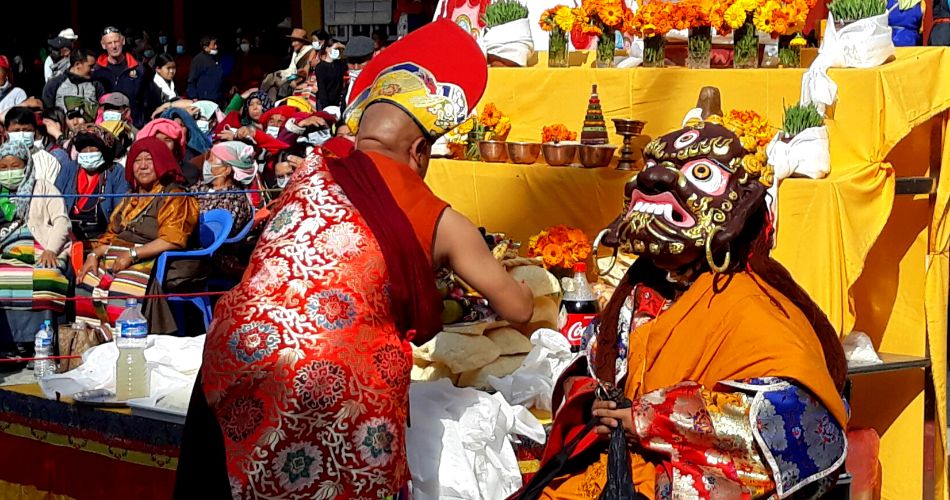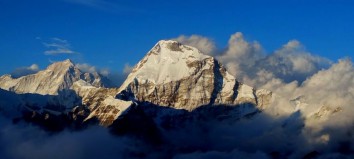Buddhism in Nepal

Buddhism has a long history in Nepal, dating back to the time of the Buddha himself who was born in Lumbini, Nepal. Today, Nepal is home to many Buddhist pilgrimage sites and monasteries, and Buddhism is an important part of the country's cultural and religious heritage.
One of the most important Buddhist sites in Nepal is Swayambhunath, also known as the Monkey Temple, which is a UNESCO World Heritage Site and a popular destination for tourists and pilgrims. Other important Buddhist sites in Nepal include Boudhanath Stupa, Lumbini, and Kopan Monastery.
Nepal has a significant Buddhist population, with estimates ranging from 10% to 15% of the country's total population. Tibetan Buddhism is the dominant form of Buddhism in Nepal, and many Tibetan refugees have settled in the country since the Chinese invasion of Tibet in 1959.
Buddhism in Nepal has played an important role in shaping the country's culture and history, and continues to be a source of inspiration and guidance for many Nepalis today.
Buddhism was founded by Siddhartha Gautama, also known as the Buddha, in ancient India around 2,500 years ago. Siddhartha was born into a wealthy family in the town of Lumbini, in present-day Nepal, and led a sheltered life until he encountered the Four Sights – an old man, a sick man, a dead man, and a monk – which led him to renounce his comfortable life and seek enlightenment.
After years of meditation and study, Siddhartha achieved enlightenment under the Bodhi tree in Bodh Gaya, India. He spent the rest of his life teaching his insights and principles to others, gathering a large following of disciples who carried on his teachings after his death.
The Buddha's teachings, known as the Dharma, emphasized the importance of self-awareness, mindfulness, and compassion, and stressed the impermanence of all things. His teachings spread throughout India and eventually reached other parts of Asia, including Nepal, Sri Lanka, China, and Japan.
Today, Buddhism is one of the world's major religions, with an estimated 500 million followers worldwide. Its teachings and practices continue to influence people around the world, and it remains an important source of inspiration and guidance for many.
Buddhism is a philosophical and spiritual tradition that emphasizes the importance of developing wisdom, compassion, and inner peace. Its philosophy is based on the teachings of the Buddha, who taught that suffering arises from craving and attachment, and that the key to happiness and liberation lies in cultivating detachment and insight.
.jpg)
One of the central concepts in Buddhism is the Four Noble Truths. The first noble truth is that suffering exists and is an inherent part of life. The second universal truth is that craving and attachment are the root causes of sufferings. The third noble truth is that it is possible to overcome suffering by letting go of attachment and craving. The fourth noble truth is the Eightfold Path, a set of guidelines for living that includes right understanding, right intention, right speech, right action, right livelihood, right effort, right mindfulness, and right concentration.
Buddhism also emphasizes the importance of mindfulness, which involves being present in the moment and aware of one's thoughts, feelings, and surroundings. Through mindfulness practice, one can develop greater awareness, clarity, and inner peace.
In addition to mindfulness, Buddhism also emphasizes the importance of compassion, both for oneself and others. Through developing compassion, one can overcome negative emotions such as anger, hatred, and jealousy, and cultivate a greater sense of connection and empathy with others.
Overall, Buddhism offers a rich and nuanced philosophy that can help individuals cultivate greater awareness, compassion, and inner peace, and live a more fulfilling and meaningful life.
Buddhism in Nepal. This religion is a way of practice and spiritual development that leads to insight into the true nature of reality. Some of them are mentioned as follow:
Vajrayana Buddhism
The traditional Buddhism of the Newars in the Kathmandu valley is a very old form of Vajrayana Buddhism. It was once widespread, traced across South Asia and beyond, to Cambodia, Java, and Bali in South Asia. From South Asia this was carried from Buddhism to Tibet, China, Vietnam, Korea and Japan. Japanese Buddhist temples have Buddhist monuments and tombstones with mantras that can be recognized in a script from Nepal. The mantras themselves are the same, if pronounced differently.
Mahayana Buddhism

Mahayana Buddhism in South Asia died out in the 13th and 14th centuries. The major monastery universities in northern India were looted and destroyed by Muslim invaders. The monks fled to Nepal and some went to Tibet. Buddhist cult centers have been absorbed by Hinduism. Naturally, Theravada Buddhism flourished in Sri Lanka and Southeast Asia. But Newar Buddhism is the only surviving remnant of Sanskrit-based Mahayana and Vajrayana Buddhism in South Asia. They are the only Buddhists in the world whose scriptures are still in Sanskrit. In the words of the great French Buddhist sylvain levi, the Kathmandu valley is like a laboratory in which one can observe and understand the coexistence of Buddhism and Hinduism, as it was in India in the first millennium. Newars Buddhism is therefore of world historical importance, and the old royal cities of Nepal-Kathmandu, Lalitpur and Bhaktapur, which form its centers, are rightly a UNESCO World Heritage Site.
Vajrayana Buddhism in Nepal focuses on sacred complexes that are colloquially known as Baha or Bahi in the Nepalese mother tongue, Nepal Bhasha. They call vihara, sanskrit and pali higher for monasteries. So each complex has two names, a colloquial, e.g. kwa baha, and an honorable, hiranya varna mahavihar.
The members of these Newar monasteries are Shakyas and Vajracharyas, who together with their families form a priestly layer at the head of Buddhist Newar society. To become a member of a Baha or Bahi, one must be the son of a previous member of a Shakya or vajracharya mother. Such a boy goes through an initiation ritual in which he becomes a monk for four days, wears monastic robes, receives Dana (religious gifts) from relatives and friends, and then on the fourth day returns his robe to the priest and is initiated into the Mahayana and Vajrayana path of the Buddhist housekeeper.
The religious duties of the Buddhist housekeeper are many in traditional Vajrayana Buddhism. The rituals are invited by the host, the traditional vajracharya of the life cycle, from the first maturation of the children to intuitions, weddings and death rites. He can also be invited to many other occasions. In addition, there are many festivals throughout the year that are celebrated in a Buddhist language. Many Guthis, socio-religious organizations, have been established in the past and endowed with land to ensure certain rituals, such as the annual observance or vrata of the Buddhist goddess of wealth and harvest, Vasundhara.
The special ritual and biblical traditions of Nepalese Vajrayana Buddhism are therefore preserved by the Vajracharya priests. both spiritually and literally they lead their way back to Shantikar Acharya, who is said to have been a king of Gaud, in today’s Bangladesh who renounced and became a Buddhist priest. He came to Nepal and is said to have consecrated the Swayambhu stupa, the holiest site of Nepalese Buddhism, and it is believed that it still lives in the secret tantric shrine of Shantipur behind the northeast corner of the stupa.
Tathagata:

Tathagata is one of the ten titles of Buddha Shakyamuni, which he used himself according to the pali canon.
You monks, in with the Devas, Mara and Brahma, in this generation with their ascetics and Brahmen, Devas and people, whatever is seen, heard and noticed, achieved, searched for and thought over by the spirit, all of this is understood by the Tathagata. That is why it is called Tathagata. Buddhaghosa even provided eight interpretations of the word in his comment sumangalavilasini on Digha Nikaya.
In Mahayana, a Tathagata is an enlightened Buddha with his Trikaya bodies. It is often equated as absolute with Prajna and Sunyata. The term is also applied to the five Dhyani Buddhas. In Vajrayana, the Tathagata in iconography and symbolism of the Trikaya means a diverse applied principle of order. The Mahaparinirvana sutra explains its nature. According to the diamond sutra, the Tathagata also has the Divine Eye, the Eye of Wisdom, the Dharma, and the Buddha Eye, which is also used to represent Yamantaka.
What is Buddhism?

Buddhism is a way of practice and spiritual development that leads to insight into the true nature of reality. Buddhist practices such as meditation are means to change oneself, to develop the qualities of awareness, kindness and wisdom. The experience developed in the Buddhist tradition over thousands of years has created an incomparable source for all those who want to walk a path that culminates in enlightenment or Buddhahood. An enlightened being sees the nature of reality absolutely clearly as it is, and lives completely and naturally in accordance with this vision. This is the goal of Buddhist spiritual life and represents the end of suffering for everyone who achieves it.
Because Buddhism does not include the idea of worshiping a creator god, some people do not see it as a religion in the normal western sense. The basic principles of Buddhist teaching are simple and practical, not permanent or permanent, actions have consequences, change is possible. Buddhism is aimed at everyone regardless of race, nationality, caste, sexuality or gender. It teaches practical methods that enable people to recognize and use their teachings to transform their experience to be fully responsible for their lives.
Who was Buddha?

Buddhism started with the Buddha. The word “Buddha” is a title that means someone who is awake in the sense that he is “awakened to reality”. The Buddha was born as Siddhartha Gautama in Nepal about 2564 years ago. He did not claim to be a god or a prophet. He was a person who was enlightened and understood life in the deepest way.
Siddhartha was born into the royal family of a small kingdom on the Indian-Nepalese border. According to the traditional story, he had a privileged upbringing, but was torn from his sheltered life when he realized that life involves the hard facts of old age, illness, and death.
This caused them to think about the meaning of life. Eventually he felt compelled to leave his palace and follow the traditional Indian way of the wandering saint, a seeker of truth. He became very adept at meditation among various teachers and then began ascetic exercises. This was based on the belief that one can free the mind by denying the flesh. He practiced deprivation so resolutely that he almost starved to death.
The Buddha:

The Buddha refers to both the historical Buddha and the ideal of Buddhahood. The entire Buddhist tradition comes from the historical Buddha, and all schools regard him as their root founder, guide, and inspiration. Taking refuge in the Buddha means seeing him as your ultimate teacher and spiritual example. It also means that you are committed to achieving Buddhahood enlightenment for all sake, which means that you have to become someone who sees the maturity of reality absolutely clearly as it is and lives fully and naturally in accordance with this vision . This is the goal of Buddhist spiritual life and represents the end of suffering for everyone who achieves it.
The Dharma:

The Dharma primarily means the Buddha’s teachings or the truth that he understood. The word “Dharma” has many meanings, but most importantly it means the immediate truth (as it is experienced by the enlightened mind). As an expression, it also includes Buddhist teachings as the truth conveyed through language and concepts. In this second sense, Dharma is the teaching that was born when the Buddha first worded his knowledge and shared it with others in sarnath, northern India. The occasion is traditionally referred to as “the first turn of the wheel of Dharma” and the eight-spoked dharma wheel is a common symbol of Buddhism.
Another meaning of dharma is the practices described in the scriptures. Despite the richness of its literature, the nature of Buddhism is very simple; It finds ways to change yourself. It could be summarized as learning to do good, stop doing evil, cleanse the heart (as the dhammapada says).
To consider the dharma as a refuge means to view it as the best guide to reality and to commit to practicing it. The Triratna approach emphasizes the central teachings that are common to all important schools. These teachings emphasize the development of mindfulness and kindness, examine our actions in the light of our ethical values, and see how our thoughts condition our lives.
Sangha:

The Buddha once said that kalyana mitrata- spiritual friendship or “friendship with what is beautiful” is all of spiritual life. Our community takes these words to heart. Kalyana mitrata, you could say, is the entire triratna Buddhist community. Triratna centers are not simply places where meditation techniques can be taught or information about Buddhism can be conveyed. When a person visits a Triratna center for the first time, they are considered a friend. You can participate in all of the centre’s public activities, including meditation courses, study and practice of Buddhism, art events, etc.
Saraswati:

She is part of the Trinity (Tridevi) of Saraswati, Lakshmi, and Parvati. All three forms help the trinity of Brahma, Vishnu and Shiva to create, maintain and regenerate the universe. The earliest known mention of Saraswati as a goddess is in Rigveda.
Bon religion:

Bön, the indigenous animist and the shamanic belief system of Tibet, revolves around the worship of nature and stands before Buddhism. Although Bön was initially the religion to which Buddhas teach was antithetical, it has now been recognized as a legitimate religion by the 14th Dalai Lama.
According to Bön religious texts, three Bon writings – mdo ‘dus, gzer mig and gzi brjid refer to the myth of Tonpa shenrab. The Bonpos regard the first two as gterma, which were rediscovered around the eleventh century, and the last as nyan brgyud (oral transmission) dictated by loden Nyingpo, who lived in the fourteenth century. In the tenth century, loden Nyingpo unveiled a term called the brilliance (Wylie, gzi brjid) that contained the story of Tonpa shenrab. He was not the first Bonpo tonic, but his terma became one of the final writings of the Bon religion. Shenrab is said to have founded the Bon religion in search of a horse stolen by a demon. Tradition also says that he was born in the country of Tagzig Olmo lung ring (as an axis mundi), traditionally identified as Mount yung drung Guntzeg (“Edifice of Nine Swastikas”), possibly Mount kailash, in western Tibet. Because of the holiness of Tagzig Olmo Lung Ring and Mount Kailash, the Bonpo consider both the swastika and number nine so happy and of great importance.
Tonpa Shenrab visited Congo and found people whose practice was to appease victims of animals. He taught them to replace offers with symbolic animal forms made from barley flour. He only taught according to the ability of the student with lower Shamanic vehicles to prepare, until with prayer, care, devotion and application they could incubate to achieve sutra, tantra and dzogchen.
Bon gauges are nine vehicles that are away in teaching categories with clear characteristics, views, practices and results. Medicine, astrology and divination are in the lower vehicles, then sutra and tantra, with Dzogchen great perfection is the highest. Traditionally, the nine vehicles are taught in three versions, as Middle, North and South Treasures. The central treasure is closest to Nyingma Nine Yanas and the northern treasure is lost. Tenzin Wangyal Rinpoche works the southern treasure with shamanism.
The 3 principle of the Bodhisattva aspect:

There are three main aspects of the path to Buddha hood. Renunciation, bodhicitta and wisdom. These are referred to as “main issues” because they play a crucial role in following the path. Most other aspects of the path can be understood as steps that are necessary to achieve renunciation, bodhicitta or wisdom, or as an expression of these three. In order to become a Buddha and to gain true and lasting happiness, one has to cultivate renunciation, bodhicitta, and wisdom. The practice of cultivating the belief that, for example, every living thing was one of your mothers is an optional element of the path because it is part of a method and not the only method of cultivating bodhicitta. So you wouldn’t say that the belief that every living thing was your mother is a fundamental aspect of the path to Buddhahood.
Bodhicitta is a fundamental aspect of the path because it is striving to become a Buddha for the good of all. If we don’t have this endeavor, we obviously won’t become Buddhas. You can’t accidentally become a Buddha. The five perfections of effort, generosity, patience, moral, discipline and concentration (as well as wisdom) are ways to express bodhicitta, because they are steps on the way to fulfill our aspiration and because every virtuous act with bodhicitta motivation is selected. It is not correct to say that bodhicitta is an expression of patience, but patience is an expression of bodhicitta. For this reason, bodhicitta is called a main aspect of the path, but the first 5 perfections are not. Similarly, we would say that we are traveling on a certain highway because we want to achieve our goal. In this way, the goal is more central to what we do than the steps we need to achieve our goal – the steps are chosen because of the goal, not the other way around.
Buddhahood is a state of mind, it is the mental activity, the way things really exist, directly perceiving, and it is the mental activity to always act with the intention of benefiting every living being. Buddhahood is also a maximum ability to help all living beings. All these elements of Buddhahood come from wisdom. A wise person always has these states of mind and this ability. For this reason, wisdom is a fundamental aspect of the path.
Renunciation can be the most misunderstood aspect of the path because many people assume that Buddhists must completely withdraw from worldly activities and live the life of an isolated monk or nun to gain enlightenment. For people who believe this, renunciation is an extreme form of askese, but that’s wrong. Buddhism is called “the middle way”, partly because it is the middle way between the extremes, trying to find happiness by doing without everyday, worldly activities, and secondly trying to find happiness through extreme askese. Renunciation is actually an attitude about the value of worldly activities and things, not total withdrawal from normal life activities. It is not necessary to give up most material possessions to either become a Buddha or to serve as a Buddha. But Buddhas do not need much in order to be of great benefit to others. Shayamuni Buddha’s teachings continue to be of immense benefit to everyone, but he only had the clothes he was wearing and the almonds bowl he was taking when he gave these teachings.
There is no conviction that true and lasting happiness cannot be found in possession of material wealth, power or glory. At best, these worldly things can only be instrumentally useful if they are skillfully used in the spiritual practices that bring true and lasting happiness. A Buddha can have wealth, power, and fame because they can be useful tools to help others, but Buddhas find happiness in the mental states that they have achieved, not from the things that they have. Achieving renunciation is the first crucial step on the path to Buddhahood, because as long as you believe that happiness can be found through the possession of worldly things, you will not turn to the spiritual practices that lead to true and lasting happiness. You will also not practice effective and authentic spiritual practices as long as you think happiness has been found in a place called “heaven”. Jesus and Buddha taught this. Jesus shared this when he said, “The kingdom of God is in you” what Jesus meant “within” is clear in your heart and in your spirit. For true and lasting.
In summary, renunciation, bodhicitta and wisdom are the three main aspects of the path, because together these achievements are the necessary and sufficient causes for true and lasting happiness. One must first develop the attitude of renunciation in order to abandon dysfunctional, worldly goals. Next, one has to develop an aspiring and engaging bodhicitta to go the authentic spiritual path, and finally one has to acquire the wisdom that is the state of gesture of a person who experiences the true and lasting happiness of a Buddha.
The 4 noble truth:

The four Aryan (or noble) truths are perhaps the most basic formulation of the Buddha’s teaching. They are expressed as follows:
All existence is dukkha. The word dukkha has been variously translated as “suffering, fear, pain” or dissatisfaction. The Buddha’s understanding was that our life is a struggle, and we find no ultimate joy or satisfaction in everything we experience. That is the problem of existence.
The cause of dukkha is desire. The natural human tendency is to attribute our difficulties to things outside of us. But the Buddha says that its root is in the mind itself. In particular, our tendency to grasp things (or push them away) fundamentally places us in conflict with what life really is.
The cessation of dukkha comes with the cessation of desire. Since we are the ultimate cause of our difficulties, we are the solution. We cannot change the things that happen to us, but we can change our answers.
There is a path that leads from dukkha. Although the Buddha gives responsibility back to the individual, he also taught methods by which we can change ourselves, such as the noble eightfold paths.
Sect in Buddhism:
Tibetan Buddhism has four main traditions:

Gelug (pa) – way of virtue, also known as the yellow hat, whose spiritual head is the Ganden Tripa sit and whose temporal head is the Dalai lama. Successive Dalai Lamas ruled Tibet from the mid 17th to 20th centuries. This order was founded by Tsongkhapa in the 14th to 15th centuries, based on the principles of the kadampa tradition. Tsongkhapa was known for both his scholasticism and virtue. The Dalai Lama belongs to the Gelugpa school and is considered the embodiment of the Bodhisattva of compassion.
Kagyu (pa) – Oral lineage. This includes a large subsection and a small subsection. The first, the Dhagpo Kagyu, includes those kagyu schools that trace back to Gampopa. In return, the Dhagpo kagyu consists of four large subs; the karma Kagyu, which is led by a karmapa, the Tsalpa Kagyu, the Barom Kagyu, and Pagtru kagyu. The once obscure shangpa kagyu, who was represented by the teacher kalu rinpoche of the 20th century, traces his story back to the Indian master Niguma, sister of kagyu parent Naropa. It is an oral tradition that deals with the experience dimension of meditation. his most famous exponent was Milarepa, an 11th century mystic.
Nyingma (pa) – The old. This is the oldest, the original order established by padmasambhava.
Sakya (pa) – Gray earth, led by Sakya Trizin, founded by khon konchog Gyalpo, a student of the great translator drokmi Lotsawa. Sakya pandita 1182 – 1251 CE was the great grandson of khon konchog Gyalpo. This school emphasizes scholarships.









